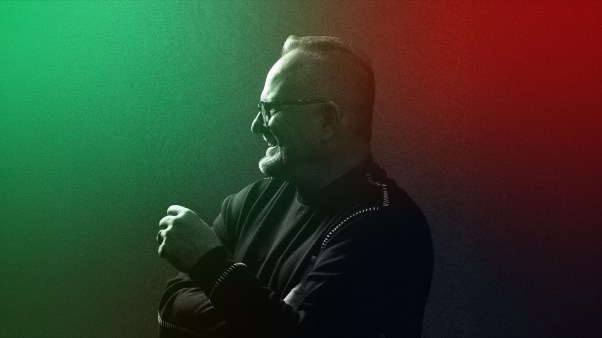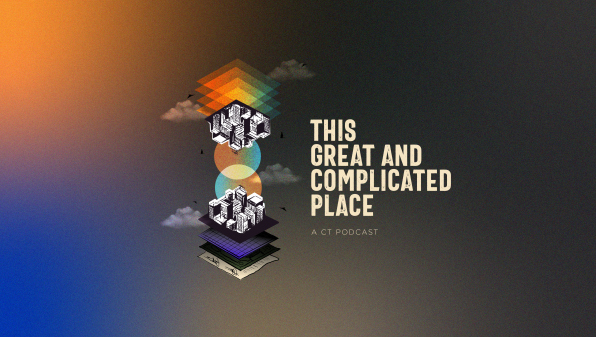As the lights flashed and the music blared out something caught my attention. It wasn’t the flashing lights nor was it the blaring music. As I stood excitedly at my first Chris Tomlin concert I was struck by the lyrics to his song “Jesus Messiah,” a song I was familiar with and had sung in my church many times, but this time, the well-known worship song was different to me.
As the opening chords played, Tomlin began to sing, quoting 2 Corinthians 5:21: “He became sin, who knew no sin. That we might become His righteousness.” I had heard the lyrics before, in fact I had the verses memorized, but for the first time, I found myself asking, “What does this actually mean? What does it mean that Jesus became sin?” This passage had been explained to me as a simple summary of the Gospel—in one sentence!—and yet I suddenly realized something those who explained it to me rarely admitted: it contains a stunning amount of complexity. Did Tomlin know what he was singing? Did I?
So, what connection does Jesus “becoming sin” have to do with my “becoming the righteousness of God?”
Misunderstanding sin?
To answer this question, we must rethink how we understand sin and salvation. Modern theological language surrounding this topic tends to be forensic in nature, meaning that it is focused on laws and ethics. To be a sinner is to be disobedient, to “miss the mark,” to break the law. Therefore, to be “saved” is to be forgiven of our transgressions. While there are forensic aspects to sin and salvation, it is reductionistic to claim that sin is merely the transgression of a law and salvation is merely legal forgiveness of said transgressions. This is important to understand because the way we understand the problem determines how we understand the solution.
In Scripture, sin is described in three ways: a path we walk, a moral standing, and a state of being. We might conceive of sin as a pie chart made up of these three elements. Most of our pie charts would have the first two—a path we walk and moral standing—comprising the majority and the third—a state of being—would only be a narrow sliver, since it is in the Bible after all. But the pie chart itself misconceives what sin essentially is.
These first two elements, corrupted living and guilty moral standing, are not what sin is, they are simply the outflow of sin. Sin’s essence must be understood as a state of being; it is a corruption of ontology. The prophet Jeremiah asks “Is there no balm in Gilead? Is there no physician there? Why then is there no healing for the wound of my people?” (8:22) The prophet views sin as an affliction that needs healing. This is echoed by Paul in Ephesians 2 when he says that we were “dead” in our transgressions and sins. Sin is a disease that we can do nothing about, however, the New Covenant that God makes with his people in Ezekiel 36:25-27 says,
I will sprinkle clean water on you, and you will be clean; I will cleanse you from all your impurities and from all your idols. I will give you a new heart and put a new spirit in you; I will remove from you your heart of stone and give you a heart of flesh. And I will put my Spirit in you and move you to follow my decrees and be careful to keep my laws.
Jeremiah’s cry for a balm to heal the sickness (sin) of his people will be given by God as promised to Ezekiel. God promises a cleansing; a new heart and a new spirit. We will be totally recreated so that we will “walk” in His statutes. Unless our corrupt natures are healed, we will never walk the correct path. For the totality of sin to be fixed, there must be a solution that is more than simply forgiveness of wrongdoing and a moral example for us to follow. There must be a solution to sin that includes the recreation of our natures, the healing of our hearts of stone. So, we don’t need a pie chart; we need a flowchart, where guilty moral standing and corrupt living are the domino effect of our sinful essential state.
In the Old Testament, atonement was made for one’s sins by participating in the sacrificial system. A lamb was sacrificed as an atonement for sins in order to gain temporary right moral standing before God. There was a problem, however, a lamb could not recreate our human nature. It only pointed towards the day when the ultimate sacrifice would come that, as Ezekiel proclaims, would provide the removal of our hearts of stone—the only solution to sin. Galatians 4:4-5 says “when the set time had fully come, God sent his Son, born of a woman, born under the law, to redeem those under the law, that we might receive adoption to sonship.” The solution to sin begins at the incarnation when Jesus assumed a human nature and “tabernacled” among us (John 1:14).
If we have misunderstood what sin is, is it possible that we have also misunderstood the solution—the atonement? If so, how should we think of it?
Often salvation is most closely—or even exclusively—linked to the cross, as the place where Jesus made payment for our sins. But while the cross may be an important exclamation point in the unfolding story of salvation, it is certainly not the whole story.
We are told that because of the cross, all we now have to do is ask Jesus to forgive us and our sin problem is fixed. While this may provide a solution to our moral standing before God it does not fix the actual problem of a corrupted nature. In order to fix the problem of sin, our salvation begins on Christmas when Jesus assumes a human nature. But, what kind of human nature did Jesus have? Was it affected by the fall? What effect does the answer to that question have on my salvation? These are the questions that began rushing through my head as I was listening to Chris Tomlin belt out “Jesus Messiah” at his concert.
A Fallen Nature?
We may take for granted that in order for Jesus to be the spotless lamb and a worthy sacrifice for our sins, Jesus had to assume a human nature that was unaffected by the fall. This is the “unfallen nature” view. However, in order for Jesus to secure redemption for fallen humans would He not need to assume a human nature that was affected by the fall? This is the “fallen nature” view.
Those who hold to the former view argue that the latter is problematic for several reasons. First, fallenness is not an attribute that is necessary for one to be fully human. For instance, Adam and Eve were fully human before the fall, thus fallenness must not be an essential attribute of being fully human. Second, if Jesus assumes a fallen human nature this would include the assumption of original sin which includes original guilt and original corruption and, according to theologian Oliver Crisp, simply by virtue of possessing this corruption “he is loathsome to God and must have the blessings of heaven withheld from him,” even if he never actually sins. If Jesus is loathsome to God because of his fallen nature and has heaven’s blessings withheld then he can’t be our savior. So, argues Crisp, this is the “issue upon which the fallenness view stands or falls.” But, is this really the end of the fallen nature view?
Theologians such as Karl Barth and T.F. Torrance argue in the spirit of Gregory of Nazianzus that “the unassumed is the unhealed.” In order for Jesus to bring healing to our sinful natures and provide a new way to be human, in the incarnation Jesus must vicariously assume a fallen human nature into union with his divine nature and divine person. In the words of 20th-century Scottish theologian T.F. Torrance, Jesus “entered into our condemned state under divine judgment and made it his own, suffered the ‘Eli, Eli, lama sabacthani,’ and yielded up the Ghost under the burden of sin and judgment and wrath.”
If sin is indeed an ontological problem that requires an ontological solution, then in this view, Jesus assumed a fallen nature because it was fallen humanity that needed a savior. Christ’s vicarious assumption of a fallen human nature was for the purpose of atonement, for removing our heart of stone and giving us a heart of flesh.
However, this view raises two important questions: First, does Jesus’ assumption of this fallen nature make Jesus sinful and therefore incapable of being our savior? Second, is this view Biblical?
A Sinful Savior?
In continuity with Chalcedonian Christology, we confess that Jesus is the pre-existent second person of the Trinity (John 8:58). This means that He possesses a divine nature and a divine person. In the incarnation, the Son vicariously assumes our fallen human nature into union with himself, thus having two natures, divine and human, united in His one person. Fallenness is a characteristic of human nature post-fall. Sinfulness—as “a perversion of the created will—is properly attributed to hypostasis [person] rather than nature,” argues Ian McFarland.
While our wills are fallen due to the indivisibility of person and nature, Jesus is exempt from this since His person pre-exists his human nature and thus, His will is not bound by His human nature. Thus, we can confess then that Christ is free from sinfulness while vicariously assuming a fallen human nature, for fallenness is a property of nature while sinfulness a property of person. So far so orthodox, but is this position Biblical?
According to the Scriptures?
For the sake of space let us examine just a few key texts. Second Corinthians 5:21 says “God made him who had no sin to be sin for us, so that in him we might become the righteousness of God.” This text has been interpreted to mean that Christ simply became a “sin offering” for us. While the word used here for “sin” is sometimes translated as “sin offering” elsewhere in the Septuagint, David Garland points out that it does not have the same meaning when used elsewhere in the New Testament. If “sin offering” is indeed what Paul meant here, he seems to be using the word inconsistently when he says Jesus “knew no sin.” It can be concluded then that Jesus was made a “sinner” on our behalf while being sinless himself in order to reconcile and unite us with God within His very person.
In Romans, Paul states “For what the law was powerless to do because it was weakened by the flesh, God did by sending his own Son in the likeness of sinful flesh to be a sin offering. And so he condemned sin in the flesh.” (Romans 8:3) Paul begins this passage by reminding the reader that the Mosaic law is not and cannot be the solution to sin. Instead, God solved the problem by sending his son in the “likeness of sinful flesh.” This is a clear argument against teachings which said that Jesus only appeared to be human. But it is important to note that Paul doesn’t just say “flesh” he indicates specifically “sinful flesh.” As Doug Moo argues, the word for likeness here “probably has the nuance of ‘form’ rather than ‘likeness’ or ‘copy.’” In other words, Jesus truly entered into the fallen human condition in order to break us free from our bondage to that fallenness. According to Moo, by entering into that fallen human condition “the condemnation that our sins deserve has been poured out on Christ, our sin-bearer; that is why ‘there is now no condemnation for those who are in Christ Jesus.’”
We find more biblical support in Hebrews 2:14, which says “Since the children have flesh and blood, he too shared in their humanity so that by his death he might break the power of him who holds the power of death—that is, the devil.” F.F. Bruce says Christ “began to share fully the nature of those whom he chose to redeem,” meaning Jesus shares the same “flesh and blood” we all have. The word translated here as “share,” according to David Allen, “describe[s] a participation in a shared reality.” In other words, when Jesus became human in the incarnation he took on the fallen/fractured nature that humanity shares in order that he might set us free from the bonds that it had us in.
He Truly Shared Our Nature
As the lights flashed, the music rang out, and Chris began to sing I never imagined I would begin a journey to understand the nature of Jesus’ humanity. But as Chris Tomlin sang the words of Paul, “He became sin, who knew no sin, so we might become His righteousness,” that journey began. What does it mean that He became sin? What does it mean that He knew no sin?
Sin placed all humanity in exile, separated from God with a corrupt nature that we can do nothing about. Jesus became a human in order to vicariously assume that corrupt fallen nature, to live obediently within that nature, raise our nature to new life and condemn sin in the flesh thus providing a new way to be human. Because sin is a corruption of nature, it is that fallen nature that Jesus assumed into union within His person. Thus, we now gain His right standing before God, and participate in His full obedience through our union with His resurrected humanity, our final balm and healing.
Daniel J. Cameron (Ph.D. candidate systematic theology, The University of Aberdeen) is an adjunct professor of theology at The Moody Bible Institute. He is the author of Flesh and Blood: A Dogmatic Sketch Concerning the Fallen Nature View of Christ’s Human Nature (Wipf and Stock, 2016).







